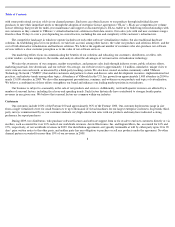VMware 2009 Annual Report Download - page 21
Download and view the complete annual report
Please find page 21 of the 2009 VMware annual report below. You can navigate through the pages in the report by either clicking on the pages listed below, or by using the keyword search tool below to find specific information within the annual report.
Table of Contents
negatively impact our revenues, anticipated cash flows and financial results due to fluctuations in foreign currency exchange rates, particularly
the Euro, the British Pound, the Japanese Yen and the Australian Dollar relative to the U.S. Dollar. While variability in operating margin may be
reduced due to invoicing in certain of the local currencies in which we also recognize expenses, increased exposure to foreign currency
fluctuations will introduce additional risk for variability in revenue-related components of our financial statements.
In July 2009, we entered into forward contracts to economically hedge a portion of our net outstanding monetary asset and liability
positions. Although we expect the gains and losses on our foreign currency forward contracts to generally offset the majority of the gains and
losses associated with the underlying foreign-currency denominated assets and liabilities that we hedge, our hedging transactions may not yield
the results we expect. Additionally, we expect to continue to experience foreign currency gains and losses in certain instances where it is not
possible or cost effective to hedge our foreign currency exposures.
We are dependent on our management and our key development personnel, and the loss of key personnel may prevent us from implementing
our business plan in a timely manner.
Our success depends largely upon the continued services of our existing management. We are also substantially dependent on the
continued service of our key development personnel for product innovation. We generally do not have employment or non-compete agreements
with our existing management or development personnel and, therefore, they could terminate their employment with us at any time without
penalty and could pursue employment opportunities with any of our competitors. Changes to management and key employees can also lead to
additional unplanned losses of key employees. The loss of key employees could seriously harm our ability to release new products on a timely
basis and could significantly help our competitors.
Because competition for our target employees is intense, we may not be able to attract and retain the highly skilled employees we need to
support our planned growth and our compensation expenses may increase.
To execute on our strategy, we must attract and retain highly qualified personnel. Competition for these personnel is intense, especially for
senior sales executives and engineers with high levels of experience in designing and developing software. We may not be successful in
attracting and retaining qualified personnel. We have from time to time in the past experienced, and we expect to continue to experience in the
future, difficulty in hiring and retaining highly skilled employees with appropriate qualifications. Many of the companies with which we
compete for experienced personnel have greater resources than we have. In addition, in making employment decisions, particularly in the high-
technology industry, job candidates often consider the value of the stock options, restricted stock grants or other stock-based compensation they
are to receive in connection with their employment. Declines in the value of our stock could adversely affect our ability to attract or retain key
employees and result in increased employee compensation expenses. If we fail to attract new personnel or fail to retain and motivate our current
personnel, our business and future growth prospects could be severely harmed.
If we are unable to protect our intellectual property rights, our competitive position could be harmed or we could be required to incur
significant expenses to enforce our rights.
We depend on our ability to protect our proprietary technology. We rely on trade secret, patent, copyright and trademark laws and
confidentiality agreements with employees and third parties, all of which offer only limited protection. As such, despite our efforts, the steps we
have taken to protect our proprietary rights may not be adequate to preclude misappropriation of our proprietary information or infringement of
our intellectual property rights, and our ability to police such misappropriation or infringement is uncertain, particularly in countries outside of
the United States. Further, with respect to patent rights, we do not know whether any of our pending patent applications will result in the
issuance of patents or whether the examination process will require us to narrow our claims. To the extent that additional patents are issued from
our patent applications, which is not certain, they may be contested, circumvented or invalidated in the future. Moreover, the rights granted
under any
18
























